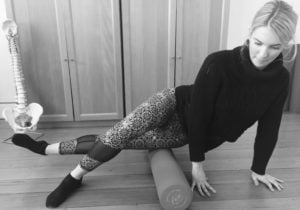How to manage ITB syndrome (AKA “Runner’s Knee”)
The Iliotibial Band (ITB) is a large piece of fascia that runs from the outer side of the hip to the knee. It is often implicated in hip and knee pain and is a well-known friend and foe of runners, cyclists and other athletes. Having this area released by your osteopath or remedial masseur can really help hip and knee pain but there are also some useful things you can do at home to maintain this area yourself.
ITB stretch
This is a great stretch for runners, cyclists and anyone with hip, knee or low back tightness. It tagets the ITB and lateral thigh but also stretches the hamstrings, low back and sacroiliac regions.
– Standing, cross one leg in front of the other. The back leg is the stretching leg and the front leg provides support. Keep the back knee straight. The supporting leg can bend a little here.
– Bend forward as if you are going to touch your toes. You may reach the floor or let your arms hang wherever the stretch takes you.
– Hold for 15-20 seconds, swap sides and repeat.
– Do not attempt this stretch if you suffer with balance problems such as vertigo or dizziness.
– Also exercise caution if you have any existing low back disc injuries – this position may aggravate your pain.
The foam roller
Many runners and athletes have a love-hate relationship with their foam rollers! They are a great way of releasing the ITB ubt also can be used on other areas such as the quadriceps, hamstrings, hip adductors, calf muscles and low back – see YouTube link below.
For the ITB…
– Lie on the foam roller as demonstrated in the photo.
– Use your supporting leg to control the amount of pressure on the ITB. It can be very painful initially.
– Begin with 10 long, slow strokes up and down the ITB from the hip all the way to the knee. As you perform these you may notice lumps or bumps in the tissues and these areas are usually more sensitive.
– Repeat this process with smaller strokes over each area of “lumpiness” 10 times and finish by holding the roller statically over the area for a count of 10 seconds.
– This may be quite painful initially but will become easier each time you do it!
We sell foam rollers at the clinic so ask Piers or Kate at your next appointment if you’re interested.
Other resources that may help you in your ITB journey…
A couple of great low back stretches from one of our previous blog posts…






